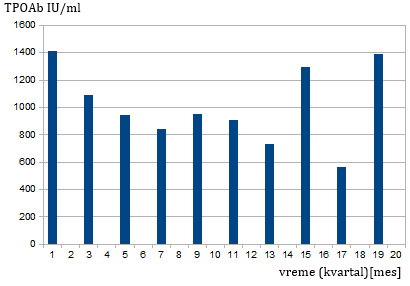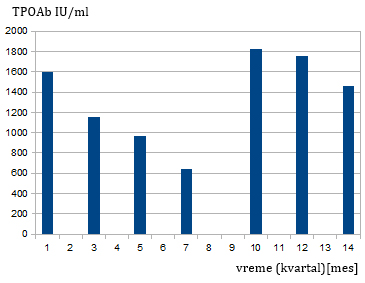|
||||||||||||||||||||||||||||||||||||
| [
Contents
] [ INDEX ]
|
||||||||||||||||||||||||||||||||||||
|
Page 13 |
||||||||||||||||||||||||||||||||||||
|
Original paper Determination of antibodies to thyroid peroxidase - further experiences Paunković Nebojša, Paunković Džejn, Nikolić Ivan SPECIALIST PRACTICE "DR. PAUNKOVIĆ" |
||||||||||||||||||||||||||||||||||||
|
|
||||||||||||||||||||||||||||||||||||
| Download in pdf format | ABSTRACT:
Introduction: Thyroid peroxidase autoantibodies are a very
important diagnostic parameter. They are mainly found in patients
with autoimmune thyroid diseases (Hashimoto's thyroiditis,
spontaneous hypothyroidism, Bazedov's disease). Objective:
Analysis of the results of the method we use in clinical practice.
Material and working methods: Autoantibodies to thyrocytic
peroxidase were determined using the Monobind method, USA. So far we
have made over 2000 determinations. The method consists of a
chemiluminescent immunoassay, using thyroid peroxidase labeled with
biotin and plastic tubes coated with streptavidin. Calibration was
done with international standard 66/387 for thyroid microsomes.
Results: In the last 8 years, we have done over 2000
determinations with hundreds of people. In about fifty of them the
examined parameter was done as a "follow-up" study. Conclusion:
We presented the results of determination of antibodies to
thyrocytic peroxidase. The method we used gives very reliable
results. During the "follow-up" study, the results were sometimes
not constant in the same subject. Key words: Autoantibodies, Thyroid microsomes, Hypothyroidism, Thyroid peroxidase |
|||||||||||||||||||||||||||||||||||
|
INTRODUCTION Thyroid peroxidase (TPO) is an enzyme that plays a role in the biosynthesis of thyroid hormones (it catalyzes the oxidation of iodide to tyrosyl residues in thyroglobulin). It is located on the apical surface of the thyroid [1]. During the destructive processes of the thyroid gland, it initiates the formation of antibodies (TPOAb) as an autoantigen [2]. These autoantibodies are used in practice as a marker of autoimmune thyroid diseases [3]. They can also be found in some other autoimmune (non-thyroid) conditions [4]. Before using the analysis of antibodies to thyroid peroxidase, testing of antibodies to thyroglobulin and later to thyroid microsomes was used to determine thyroid autoantibodies. In recent years, it has been clarified that the antigenic substance in microsomes is actually thyroid peroxidase. The author published his experiences for the first time in 1985 [5] and published them in a foreign magazine in 1998 [6]. It was last published in this journal in 2017 [7] At that time, we used several methods for determining TPOAb from the following manufacturers: Thermo, Roche, Cobas, Beckman Coulter, and Monobind, USA. In this paper, only the results of this last manufacturer are presented, on a large number of samples, on several examined patients, on healthy people (control group) and in one part in the form of a "follow-up" study. PURPOSE OF THE WORK We tried to choose the method that suits us best: one that can be used in a small number of samples, on an inexpensive measuring device, one that gives reproducible results, one that has "normal values" like other methods (some of the methods used have reference values up to 9 IU/ml, most of the others have between 35 and 60). In patients and in a healthy control group, we monitored reproducibility over a longer period of time. PATIENTS AND METHODS Chemiluminescent immunoassay was used to determine autoantibodies
to thyroid peroxidase. Monobind microplates Limit value is 40.
Monobind Inc.- Lake Forest, CA 92630 USA. The samples were measured
on a Lumi Stat device. The device is designed to be used for a small
number of samples. RESULTS In the last 8 years, since we have been doing TPOAb determination using the Monobind method, we have done 2040 samples. We treated a large control group of healthy individuals or patients with non-thyroid diseases. We have shown the values in graph 1. Graph 1. TPOAb in a control group of healthy individuals or patients with non-thyroid diseases.
The group of patients with autoimmune thyroiditis (Hashimoto's),
consisted of 323 patients with hypothyroidism, and 156 who were
still in the euthyroid phase, although we prescribed l-thyrokinin
replacement for most of them, especially if the values of antibodies
to thyroid peroxidase were very high . DISCUSSION Thyroid peroxidase antibodies (TPOAb) are a parameter used in clinical work to evaluate chronic thyroid diseases. It is especially useful in the first described autoimmune disease - Hashimoto's thyroiditis. The height of this parameter probably depends on the degree of destruction of the thyroid tissue. Unlike the second parameter of thyroid autoimmunity - thyrotropin receptor antibodies (TRAb), which returns to normal with the passing of immunogenic hyperthyroidism, TPOAb is almost always constant. That's why in these papers we examined what could influence the level of these antibodies. We considered the technical details first. Different kits for testing this parameter do not always have the same "normal values", for example, the Beckman Coulter company has reference values up to 9 IJ/ml, unlike other methods that have upper limits of normal from 35-60 (7). It is likely that other epitopes were used for immunization in the production of autoantibodies. A practical tip is to always use the same method if you want to monitor the parameter in the same patient. This is especially important if one wants to use some drugs or supplements (selenium) to influence the course of the disease (8,9). In this work, during the "follow-up" studies, we noticed that about 30% of patients who were only on thyroxine replacement therapy, and do not take other drugs that could eventually affect this parameter (TPOAb), do not have a constant level ( graph 2 and 3). Graph 2. Monitoring of thyrocytic peroxidase antibody concentrations from 2016 to 2021 in patient P.B.
Graph 3. Monitoring of thyrocytic peroxidase antibody concentrations from 2016 –2019 in patient S.C.
CONCLUSION We presented the results of determination of antibodies to thyrocytic peroxidase. The method we used provides reliable data. The parameter itself is not reliable in routine work - during the continuous monitoring of its value, oscillations occasionally occur for which we have not found an explanation. Is there an occasional increase in destructive processes? In further work, we will try to find an answer to that question. LITERATURE:
|
||||||||||||||||||||||||||||||||||||
|
|
||||||||||||||||||||||||||||||||||||
| [
Contents
] [ INDEX ]
|
||||||||||||||||||||||||||||||||||||
|
||||||||||||||||||||||||||||||||||||



